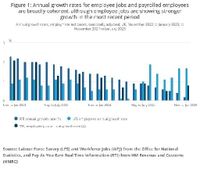The UK jobs market is demonstrating unexpected resilience in light of looming employer tax increases, according to recent reports. Though multiple surveys have indicated a weakening appetite for hiring as businesses brace for tax hikes starting next month, the official labor market data paints a different picture. As of now, employment numbers remain stable, and redundancy figures show no significant rise, leaving many analysts cautiously optimistic about the market's trajectory.
Private sector employment has been described as relatively flat throughout 2024, excluding sectors heavily reliant on government support. Employers reported having 30.4 million payrolled employees as of February 2025, marking an increase of 21,000 (0.1%) from the previous month, and up 66,000 (0.2%) from a year earlier. This stable employment figure stands in stark contrast to the dire forecasts stemming from a series of surveys predicting a reduction in hiring.
Describing the current labor market conditions, layoffs do not seem to be escalating. Official data indicates that redundancy notifications, which employers must file when laying off more than 20 staff members, have not increased significantly in the lead-up to the tax changes. Such findings could signal a delay in the expected fallout from the coming tax increases.
The anticipated nearly 7% rise in the National Living Wage come April could provide additional pressure, yet, as of now, positions in sectors like hospitality and retail—considered particularly sensitive to tax changes—remain around pre-Covid levels.
Despite the absence of immediate impacts, market analysts remain vigilant for shifts. One significant aspect of the conversation revolves around the Bank of England's monetary policy. With the bank’s decision imminent, some policymakers are divided on how to react to the current labor conditions. Catherine Mann gained attention in February when she shifted from favoring a hawkish stance on interest rates to advocating for more aggressive rate cuts, suggesting an adjustment to 50 basis points. The reason behind her call dealt heavily with the potential for "non-linear" declines in employment should the tax amendments severely impact businesses.
While Mann’s perspective highlights an inherent risk to future employment, market data thus far does not seem to support pronounced concerns. The latest estimates suggest the annualized change in private sector pay has also been slowing, currently clocking in at 3.7% in January 2025, down from the previously higher growth rates seen in 2024. To put it into more context, the year-on-year private sector pay growth rate hovers just above 6%, but expectations suggest it might decrease over the upcoming months.
As for the broader economic picture, the UK's unemployment rate for individuals aged 16 and over stands at 4.4%, while the employment rate for the same demographic is at 75.0% between November 2024 and January 2025. Notably, the economic inactivity rate mirrors a decrease to 21.5%, suggesting a productive shift back into the labor fold for many individuals.
The implications of the current labor market dynamics extend beyond employment figures; they touch upon economic growth and cash flows through the economy. ING Think anticipates a consistent approach from the Bank of England, predicting further quarterly rate cuts through 2026, with a terminal rate expectation set at 3.25%, contrasting with the market's pricing close to 3.90%.
In the context of annual pay growth, employees' average regular earnings in Great Britain saw a nominal rise of 5.9% excluding bonuses, with a total earnings growth inclusive of bonuses holding similarly at 5.8% for the period spanning November 2024 to January 2025. Furthermore, in real terms—adjusted for inflation as measured by the Consumer Prices Index including owner occupiers’ housing costs (CPIH)—regular pay growth stands at 2.2%, with total pay slightly lower at 2.1%.
Challenges in labor disputes haven’t entirely disappeared, with estimates suggesting approximately 50,000 working days lost due to strikes and related issues in January 2025. Yet, the general sentiment seems to reflect a cautious stability rather than anticipated chaos, with many employers likely hoping for a smooth transition once tax hikes come into effect.
Experts also point to fluctuating data as a theme throughout the labor landscape. While preliminary data can be volatile, particularly noted in payrolled employees' statistics, the overall coherence of various employment datasets—including Workforce Jobs (WFJ) and Claimant Count data—suggests a more stable overarching trend.
The labor market's general performance now sets the stage for further discussions regarding economic strategies and forecasts within the UK. As rising employer taxes loom and the implications of wage growth become clearer, vigilance from both businesses and policymakers will be paramount in navigating these potentially turbulent waters. Will the resilience seen today hold up against the inescapable coming changes? Only time will unveil the broader ramifications of these evolving dynamics in the UK job market.


